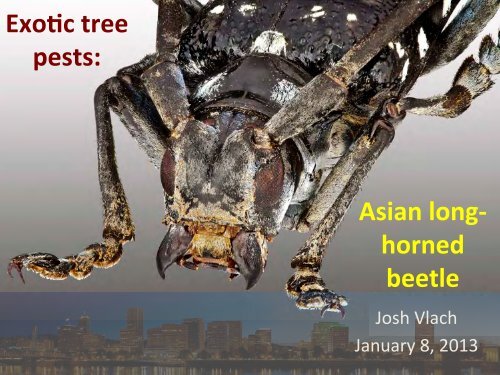Asian Longhorn Beetle
Asian Longhorn Beetle
Asian Longhorn Beetle
Create successful ePaper yourself
Turn your PDF publications into a flip-book with our unique Google optimized e-Paper software.
Exo3c tree<br />
pests:<br />
<strong>Asian</strong> long-‐<br />
horned<br />
beetle<br />
Josh Vlach<br />
January 8, 2013
Families of importance<br />
• Bark and ambrosia<br />
beetles (Scoly>nae)<br />
• Ambrosia beetles<br />
(Platypodinae)
Families of importance<br />
• Metallic or flat-‐headed<br />
woodborers<br />
(Bupres>dae)<br />
• Horntails (Siricidae)
Families of importance<br />
• <strong>Longhorn</strong>ed or round-‐headed woodborers<br />
(Cerambycidae)
Is this really a problem?<br />
• Other important<br />
woodboring pests<br />
– Mountain pine beetle<br />
(Dendroctonus<br />
ponderosae)<br />
– Dutch elm disease<br />
(Scolytus scolytus, S.<br />
mul4striatus, and now<br />
S. schevyrewi)
Is this really a problem?<br />
– Bronze birch borer<br />
(Agrilus anxious)<br />
hOp://www.missouribotanicalgarden.org/<br />
Portals/0/Gardening/Gardening%20Help/<br />
images/Pests/Bronze_Birch_Borer898.jpg<br />
– Emerald ash borer<br />
(Agrilus planipennis)
Is this really a problem?<br />
– Walnut twig beetle/<br />
thousand cankers<br />
disease (Pityophthorus<br />
juglandis)<br />
– European woodwasp<br />
(Sirex noc4lio)
How do they get here?<br />
• Crate<br />
• Pallet<br />
• Dunnage<br />
• Logs<br />
• Firewood<br />
• Wood cra[s<br />
• Live plant material
What damage can they do?<br />
• Damage cambium
What damage can<br />
they do?<br />
• Phytotoxic mucus
What damage can they do?<br />
• Disease vector<br />
hOp://www.plantmanagementnetwork.org/elements/view.aspx?ID=4593
What damage can they do?<br />
• Mechanical damage
Life cycle<br />
• Summer-‐ oviposi3on
• Larvae hatch<br />
Life cycle<br />
• Larvae take 1-‐2 years to develop
Life cycle<br />
• Overwinter as larvae or pupae<br />
• Adults can emerge May through<br />
November
• Preferred<br />
– Maple<br />
– Birch<br />
– Willow<br />
– Elm<br />
– Horsechestnut<br />
– Buckeye<br />
Hosts<br />
• Possible<br />
– Alder<br />
– Apple<br />
– Ash<br />
– Cherry<br />
– Mountain ash<br />
– Oak<br />
– Pear<br />
– Plane tree<br />
– Plum<br />
– Poplar, CoNonwood<br />
– Russion Olive
<strong>Asian</strong> longhorned beetle<br />
• Originally from China and Korea<br />
• First found in: Brooklyn 1996<br />
– 1998 Chicago<br />
– 2002-‐04 New Jersey (3 loca3ons)<br />
– 2008 Worcestor County,<br />
MassachuseNs<br />
– 2010 Clermont County, Ohio
<strong>Asian</strong> <strong>Longhorn</strong>ed beetle<br />
• Eradicated:<br />
– 2008 Chicago<br />
• Hudson Co., NJ<br />
– 2011 Islip, NY
• Intercepted in 17 states, including California<br />
and Washington
How do we find it early?<br />
• Traps and lures?<br />
• ODA surveys?<br />
• General public?
Iden3fy<br />
the beetle
Oregon fir sawyer<br />
Monochamus scutellatus oregonensis<br />
Na3ve look-‐alikes
Rosalia funebris (Banded alder borer)<br />
Na3ve look-‐alikes
Iden3fy damage:<br />
oviposi3on scar
Iden>fy damage:<br />
emergence holes
Boring dust
ALB Training Simula3on Course
Training is very beneficial<br />
• 2 courses<br />
– 1 st 3me 16% passage<br />
– 2 nd 3me 80% passed
What happens then?<br />
• Mechanical control<br />
• Chemical control
• Imidacloprid<br />
Chemical control<br />
• Trunk and/or soil injec3ons<br />
• Start in March/April<br />
– May treat through July under the right<br />
condi3ons<br />
• Will not save infested trees<br />
• Protects trees from aNack
• Cut<br />
• Chip<br />
• Replant non-‐host<br />
Mechanical control
The Best Op3on<br />
• Don’t let it get here in the first place!<br />
– Only inspect ~2% of imports<br />
– Good SWPM treatment rules<br />
• Interna>onal Plant Protec>on Conven>on-‐ based on<br />
EAB a subcor>cal pest!<br />
• Several incidents of blatant problems<br />
• Must be enforced<br />
– Tighter controls on wood movement in the US<br />
– Especially firewood (but also one of the most difficult to<br />
regulate)<br />
– OR Rule: Firewood restric>ons to prevent<br />
transport of invasive species (ORS 603-‐052-‐1080)
It doesn’t stop here<br />
• The list of new exo3c pests is long. Our<br />
lax efforts will result in establishment of<br />
these pests eventually. Others to look for<br />
in the future:<br />
– Tremex woodwasps<br />
– Redbay ambrosia beetle (Xyleborus<br />
glabratus)<br />
– European woodwasp (Sirex noc5lio)<br />
– And . . .
If you are unsure, give the ODA a call!
Risks we’re unaccustomed to<br />
• Red turpen>ne beetle (Dendroctonus<br />
valens) in China


